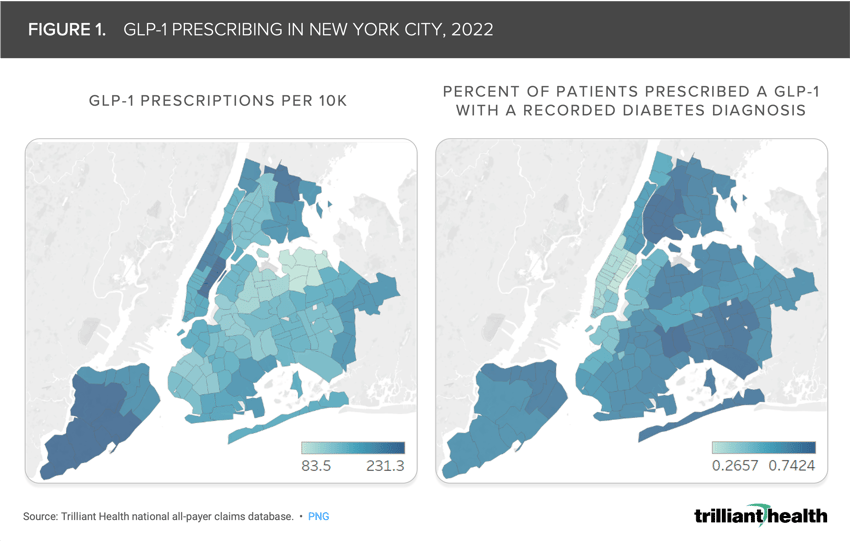The Compass
Sanjula Jain, Ph.D. | September 10, 2023GLP-1 Utilization in New York City Is Not Correlated with Clinical Indication
Key Takeaways
-
GLP-1s have the potential to revolutionize clinical treatment of obesity and diabetes, but current utilization patterns of GLP-1s are not correlated with clinical disease, primarily because of off-label use.
-
In New York City, prescribing of GLP-1s is concentrated in the Upper East Side neighborhood with 231.3 patients per 10K individuals, but only a quarter of this population has a recorded type 2 diabetes diagnosis.
-
Of the patients prescribed GLP-1s in New York City, 43.8% do not have a recorded type 2 diabetes diagnosis. The non-diabetes population skews younger, is 74.7% female and is 90.6% commercially insured.
The unprecedented demand for prescription drugs, specifically GLP-1 receptor agonists (GLP-1s), for type 2 diabetes and obesity has gained significant attention. Given abundant media coverage of these drugs, persistent off-label use and supply shortages, we examined GLP-1 use in a densely populated and diverse geographic area—New York City.
Background
GLP-1s have been used for nearly two decades to treat type 2 diabetes.1 Sold by Novo Nordisk under the brand names Ozempic®, Wegovy® and Rybelsus® and by Eli Lilly under the brand name Mounjaro®, these drugs have been in short supply for months. Most notably, off-label use of Ozempic®, which is solely indicated for type 2 diabetes, for weight loss has grown increasingly common.2
Our prior research revealed a substantial increase in the number of patients prescribed drugs like Ozempic® and Mounjaro®. Patient volumes for GLP-1s more than tripled between Q1 2020 and Q3 2022, yet only 57.0% of these patients had an official type 2 diabetes diagnosis.3 Without insurance, GLP-1s can cost between $892 to $1,300+ per month, and insurers are far less likely to reimburse the cost of drugs prescribed for off-label use.4
The unknown long-term side effects of off-label GLP-1s, high cost per treatment and supply challenges could have serious implications for all healthcare stakeholders. Thus, analyzing patient demographics and the extent of both on-label and off-label use is needed. Additionally, it is useful to understand these trends within a major market like New York City, as opposed to the national level alone. Intra-market variation, especially for such a financially and demographically diverse area, reveals trends likely impacting the entire U.S. market.
Analytic Approach
Leveraging national all-payer medical and pharmacy claims data, we examined prescription volumes for three GLP-1s, Ozempic®, Wegovy® and Mounjaro®, across 34 New York City neighborhoods in 2022. For each neighborhood, we identified the number of patients with GLP-1 activity per 10K individuals, the proportion with a type 2 diabetes diagnosis and select patient demographics (i.e., age, gender, insurance source).
Findings
In New York City, 56.2% of patients prescribed a GLP-1 have a documented type 2 diabetes diagnosis. Among these patients who both take a GLP-1 and have diabetes, the average age is 59.2, and 73.5% are commercially insured. In contrast, patients prescribed this medication without a type 2 diabetes diagnosis are younger (average age of 47.5), more likely to be commercially insured (90.6%) and female (74.7%).
At the neighborhood level, the highest rate of GLP-1 utilization was in Upper East Side/Gramercy with 231.3 patients per 10K individuals (Figure 1). Within that population, 67.8% were female, the average patient age was 49.6 and 26.6% had type 2 diabetes. Conversely, the East New York/New Lots neighborhood had the lowest GLP-1 utilization rate of 121.3 per 10K individuals. Within that population, the average patient age was 53.5 and a higher proportion (74.2%) had diabetes.
The mismatch between clinical indication and demand for GLP-1s in New York City is primarily attributable to off-label use (i.e., utilization by patients without Type 2 diabetes). The Upper East Side neighborhood has one of the highest life expectancies and the lowest rates of diabetes and obesity in New York City, and yet prescriptions for GLP-1s are concentrated in that neighborhood. 5,6 However, in East New York, which has one of the highest obesity rates in New York City, GLP-1 prescribing rates are lower than more affluent neighborhoods and are more concentrated among patients with a type 2 diabetes diagnosis.7
GLP-1s have the potential to transform the way obesity and diabetes are treated. The long-term effects of off-label use of GLP-1 medications for non-obese younger adult patients without type 2 diabetes remain unclear. However, heightened demand is resulting in lack of supply for patients who meet the clinical indications for these drugs. Moreover, increasing supply to meet demand (including off-label) may not be sufficient in making these medications available for high-need patients. Will adjusting prescribing patterns to regulate demand for patients with clinical indication ensure appropriate access?
As health plans—both public and private—analyze and revise coverage arrangements for GLP-1s, it is critical to understand the demographics of patients currently prescribed these medications. As healthcare spending approaches 20% of U.S. GDP, increased demand for an expensive drug used by many for non-clinically indicated weight loss is likely to have a profound impact on healthcare expenditures, health equity and the overall health status of American patients.
To learn more, please see a recent article from The New York Times that featured our study findings.
Thanks to Matt Fili, Sarah Millender, Austin Miller, Alli Oakes and David Taylor for their research support.
- Specialty Care
- Cost of Care
- Life Sciences
- Disease Burden
You are currently viewing a free preview of our premium studies. To receive new studies weekly, upgrade to Compass+ Professional.
Sign UpSee more with Compass+
You are currently viewing the free version of this study. To access the full study, subscribe to Compass+ Professional for $199 per year.
Sign Up for Compass+